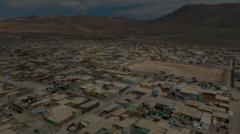The innovative technique of fog harvesting works by using fine mesh structures placed between poles. As moisture-laden fog passes through, droplets are collected and funneled into storage systems. While fog harvesting has been in use on smaller scales in various rural areas across South and Central America for decades, researchers predict the advent of larger-scale operations could fulfill the crucial water needs of urban environments.
The team assessed the potential of fog captured from condensing clouds that flow over the Pacific Ocean, arriving at productive strategies to harvest substantial volumes of water. Their findings, published in the journal Frontiers of Environmental Science, suggest that with 17,000 square meters of mesh, about 300,000 liters of water weekly could be harvested—sufficient to meet the current demand being supplied by water trucks.
Moreover, the collected fog water could be utilized for agricultural purposes, such as hydroponics, enabling greater food production for communities struggling with limited resources. As climate change exacerbates the water crisis in already vulnerable areas, this method presents a viable path toward improving resilience and accessibility to clean water. Dr. Gamberini emphasizes Chile's unique geographical advantages—coastline and mountains—that make fog harvesting not only feasible but essential in combating water shortages.
The ongoing development of a comprehensive "fog harvesting map" could enhance future sustainable water solutions for cities in water-stressed regions.
In conclusion, the potential of fog harvesting shines a hopeful light on innovative strategies to address water scarcity in urbanized deserts, thereby improving living conditions and supporting climate resilience.
The team assessed the potential of fog captured from condensing clouds that flow over the Pacific Ocean, arriving at productive strategies to harvest substantial volumes of water. Their findings, published in the journal Frontiers of Environmental Science, suggest that with 17,000 square meters of mesh, about 300,000 liters of water weekly could be harvested—sufficient to meet the current demand being supplied by water trucks.
Moreover, the collected fog water could be utilized for agricultural purposes, such as hydroponics, enabling greater food production for communities struggling with limited resources. As climate change exacerbates the water crisis in already vulnerable areas, this method presents a viable path toward improving resilience and accessibility to clean water. Dr. Gamberini emphasizes Chile's unique geographical advantages—coastline and mountains—that make fog harvesting not only feasible but essential in combating water shortages.
The ongoing development of a comprehensive "fog harvesting map" could enhance future sustainable water solutions for cities in water-stressed regions.
In conclusion, the potential of fog harvesting shines a hopeful light on innovative strategies to address water scarcity in urbanized deserts, thereby improving living conditions and supporting climate resilience.





















